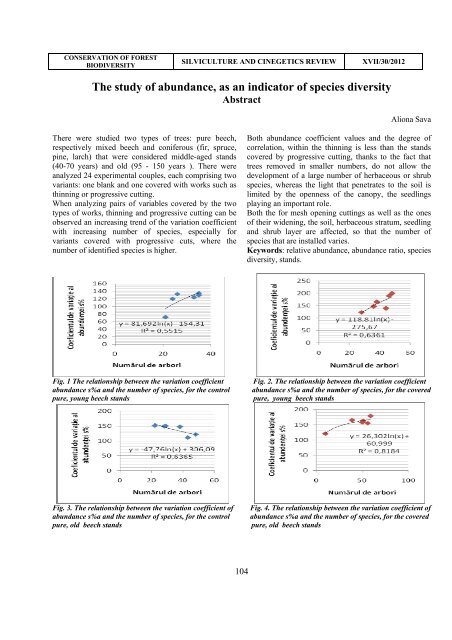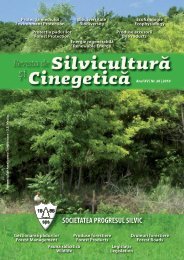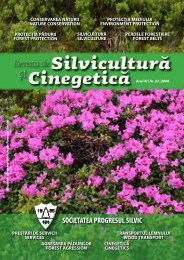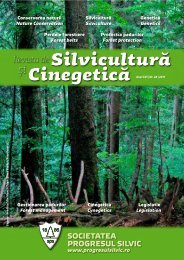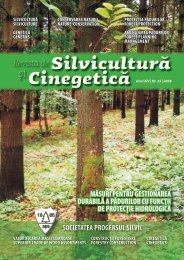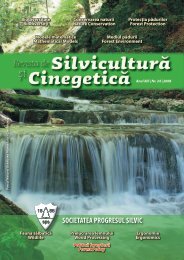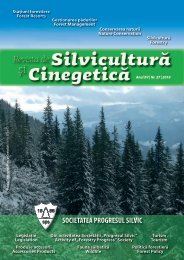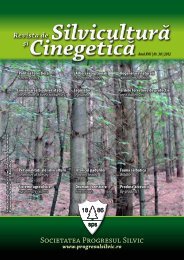Silviculture and Cinegetics Review - Societatea Progresul Silvic
Silviculture and Cinegetics Review - Societatea Progresul Silvic
Silviculture and Cinegetics Review - Societatea Progresul Silvic
You also want an ePaper? Increase the reach of your titles
YUMPU automatically turns print PDFs into web optimized ePapers that Google loves.
CONSERVATION OF FOREST<br />
BIODIVERSITY<br />
SILVICULTURE AND CINEGETICS REVIEW<br />
XVII/30/2012<br />
The study of abundance, as an indicator of species diversity<br />
Abstract<br />
Aliona Sava<br />
There were studied two types of trees: pure beech,<br />
respectively mixed beech <strong>and</strong> coniferous (fir, spruce,<br />
pine, larch) that were considered middle-aged st<strong>and</strong>s<br />
(40-70 years) <strong>and</strong> old (95 - 150 years ). There were<br />
analyzed 24 experimental couples, each comprising two<br />
variants: one blank <strong>and</strong> one covered with works such as<br />
thinning or progressive cutting.<br />
When analyzing pairs of variables covered by the two<br />
types of works, thinning <strong>and</strong> progressive cutting can be<br />
observed an increasing trend of the variation coefficient<br />
with increasing number of species, especially for<br />
variants covered with progressive cuts, where the<br />
number of identified species is higher.<br />
Both abundance coefficient values <strong>and</strong> the degree of<br />
correlation, within the thinning is less than the st<strong>and</strong>s<br />
covered by progressive cutting, thanks to the fact that<br />
trees removed in smaller numbers, do not allow the<br />
development of a large number of herbaceous or shrub<br />
species, whereas the light that penetrates to the soil is<br />
limited by the openness of the canopy, the seedlings<br />
playing an important role.<br />
Both the for mesh opening cuttings as well as the ones<br />
of their widening, the soil, herbaceous stratum, seedling<br />
<strong>and</strong> shrub layer are affected, so that the number of<br />
species that are installed varies.<br />
Keywords: relative abundance, abundance ratio, species<br />
diversity, st<strong>and</strong>s.<br />
Fig. 1 The relationship between the variation coefficient<br />
abundance s%a <strong>and</strong> the number of species, for the control<br />
pure, young beech st<strong>and</strong>s<br />
Fig. 2. The relationship between the variation coefficient<br />
abundance s%a <strong>and</strong> the number of species, for the covered<br />
pure, young beech st<strong>and</strong>s<br />
Fig. 3. The relationship between the variation coefficient of<br />
abundance s%a <strong>and</strong> the number of species, for the control<br />
pure, old beech st<strong>and</strong>s<br />
Fig. 4. The relationship between the variation coefficient of<br />
abundance s%a <strong>and</strong> the number of species, for the covered<br />
pure, old beech st<strong>and</strong>s<br />
104


